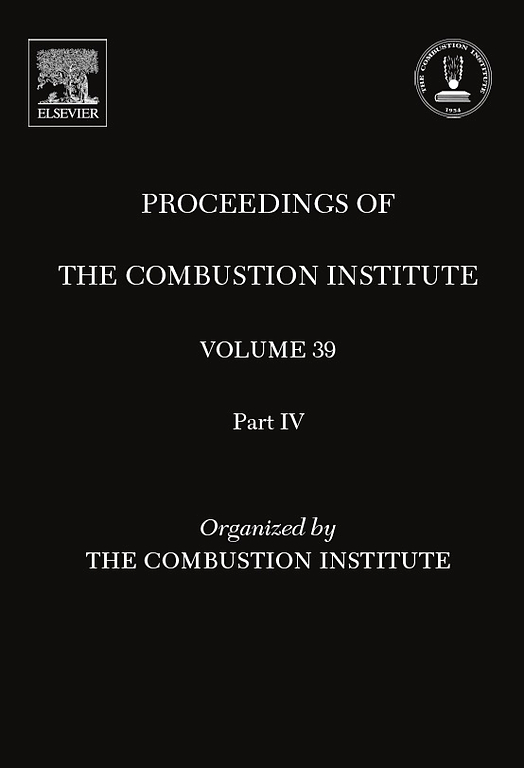利用包括冠醚在内的简化动力学机制建立可逆烟尘成核模型
IF 5.3
2区 工程技术
Q2 ENERGY & FUELS
引用次数: 0
摘要
冠烯的可逆二聚化被应用到基于矩法的混合烟尘模型中,并与新生成的乙烯燃烧还原机制一起使用。所采用的半自动还原机理方法包括一种新的误差函数,该函数使用逆流扩散火焰的物种分子分数、温度和热释放曲线匹配,并将其添加到路径通量分析和随后的敏感性分析中。生成的简化机制既保持了对所选高级芳烃的可预测性,又大大减少了所需的计算资源,并对层流预混和逆流扩散乙烯火焰中较低碳氢化合物和芳烃的物种浓度进行了验证。然后用它来模拟冠烯的可逆二聚化,并预测几种层流预混火焰的烟尘体积分数。在分析的案例中,将新的还原机制与包括可逆二聚化在内的增强型烟尘模型相结合,能够增强对烟尘浓度趋势的预测。最后,对与二聚化平衡常数有关的不确定性进行了讨论。本文章由计算机程序翻译,如有差异,请以英文原文为准。
Modeling reversible soot nucleation with a reduced kinetic mechanism including coronene
Reversible dimerization of coronene is implemented into a hybrid method of moment based soot model and used with a newly generated reduced mechanism for ethylene combustion. The employed semi-automated mechanism reduction approach includes a novel error function using curve matching of species mole fraction, temperature, and heat release profiles of a counterflow diffusion flame, which was added to a path flux analysis with subsequent sensitivity analysis. The generated reduced mechanism, which maintains predictability of selected higher aromatics, while drastically reducing required computational resources, was validated for species concentration of lower hydrocarbons and aromatics for laminar premixed and counterflow diffusion ethylene flames. It was then used to model reversible dimerization of coronene and to predict soot volume fraction for several laminar premixed flames. For the analyzed cases, the combination of the newly reduced mechanism with the enhanced soot model, including reversible dimerization, was able to enhance the prediction of soot concentration trends. Finally, a discussion on uncertainties related to the equilibrium constant for dimerization is presented.
求助全文
通过发布文献求助,成功后即可免费获取论文全文。
去求助
来源期刊

Proceedings of the Combustion Institute
工程技术-工程:化工
CiteScore
7.00
自引率
0.00%
发文量
420
审稿时长
3.0 months
期刊介绍:
The Proceedings of the Combustion Institute contains forefront contributions in fundamentals and applications of combustion science. For more than 50 years, the Combustion Institute has served as the peak international society for dissemination of scientific and technical research in the combustion field. In addition to author submissions, the Proceedings of the Combustion Institute includes the Institute''s prestigious invited strategic and topical reviews that represent indispensable resources for emergent research in the field. All papers are subjected to rigorous peer review.
Research papers and invited topical reviews; Reaction Kinetics; Soot, PAH, and other large molecules; Diagnostics; Laminar Flames; Turbulent Flames; Heterogeneous Combustion; Spray and Droplet Combustion; Detonations, Explosions & Supersonic Combustion; Fire Research; Stationary Combustion Systems; IC Engine and Gas Turbine Combustion; New Technology Concepts
The electronic version of Proceedings of the Combustion Institute contains supplemental material such as reaction mechanisms, illustrating movies, and other data.
 求助内容:
求助内容: 应助结果提醒方式:
应助结果提醒方式:


